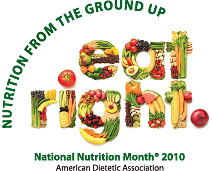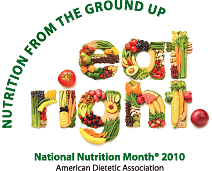March has truly become one of my favorite months. One of the reasons is that it is National Nutrition Month®. Each year the American Dietetic Association and dietitians across th
 e country use March as the month to refocus everyone's attitudes towards eating healthy. I love this years' theme of "Nutrition From the Ground Up." It is a reminder to all of us that the easy way to focus on eating better is to start with the basics: build your nutritional health from the ground up.
e country use March as the month to refocus everyone's attitudes towards eating healthy. I love this years' theme of "Nutrition From the Ground Up." It is a reminder to all of us that the easy way to focus on eating better is to start with the basics: build your nutritional health from the ground up.
Going back to the basics is the first step. Here are a few things to help you to build and strengthen your healthy eating foundation.
1. Focus on fruits and veggies: Most Americans are not eating the recommended amounts of fruits and vegetables (about 5 cups total each day). Fruits and vegetables are important sources of essential vitamins and minerals as well as being low in calories and fat. I encourage you to count how many you and your family are eating each day to see how you measure up.
2. Look locally: From farmer's markets to community-supported agriculture, you have many options to find new, fresh foods in your area. At Great Harvest, we love buying local as much as we can and go out of our way to support family-run farms.
3. Make calories count: Too often, people think of foods as good or bad, so we try to eat only those on the ‘good foods' list. When you're choosing between options, focus instead on the one with more of the vitamins and nutrients that you need. Sometimes, foods with fewer calories aren't always the healthiest options. Remember all foods are good in moderation.
4. Test your taste buds: A healthy eating plan emphasizes fruits, vegetables, whole grains, low-fat or fat-free dairy and includes lean meats, poultry, fish, beans and nuts. Those are the basics but too often we get stuck in a rut of only eating the same five things. Branch out and try new recipes, new fruits and vegetables, or a tasty, savory whole grain bread.
5. Be aware of portion sizes: Even low-calorie foods can add up when portions are larger than you need. As a general rule start with a small handful or fist size portion. If you are still hungry, go back for more. Eating slower can also help keep portion sizes in check.
For more information about the basics of eating health check out www.mypyramid.gov and www.eatright.org/nnm.
What things do you do to eat right?



